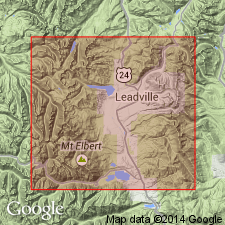
- Usage in publication:
-
- Parting quartzite*
- Modifications:
-
- First used
- Dominant lithology:
-
- Quartzite
- AAPG geologic province:
-
- Eagle basin
Summary:
First published use as a local [informed] name for a persistent bed of white quartzite. Overlies the "white limestone" of Silurian age. Underlies Blue limestone of Carboniferous age. Has a average thickness of 10 to 40 ft. Fossil evidence meager. Niagara fossils near base. Trenton and "Calciferous" forms found in float may have come from this unit. Table shows unit in section in Mosquito [Range]. Lake Co., CO lies in the Eagle basin. Assigned to the Silurian.
Source: GNU records (USGS DDS-6; Denver GNULEX).
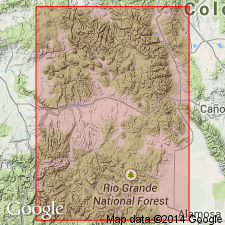
- Usage in publication:
-
- Parting quartzite member*
- Modifications:
-
- Revised
- AAPG geologic province:
-
- Eagle basin
Summary:
A term used in earlier literature as a descriptive rather than a geographic term. Because it is widely used, the name is given stratigraphic status as the Parting quartzite member, basal member of the newly named Chaffee formation in the Leadville and Alma districts. The Parting Spur of West Dyer Mountain in the Leadville district, Lake Co, CO, Eagle basin, stated to be the type area. Assigned a Devonian age.
Source: GNU records (USGS DDS-6; Denver GNULEX).
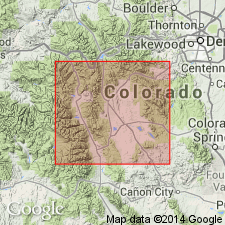
- Usage in publication:
-
- Parting member*
- Modifications:
-
- Revised
- AAPG geologic province:
-
- Eagle basin
- South Park basin
Summary:
Designated as lower member of the Chaffee formation for Parting spur of Dyer Mountain which separates Dyer and Evans amphitheaters, east-southeast of Leadville, Lake Co, central CO, in Eagle basin and into Park Co in South Park basin. Composed of lower dark-brick-red shale overlain by a light-green shale about 22 ft thick, and an overlying 40 ft thick quartzite. Overlies unconformably the Manitou limestone (formerly called "White" limestone by miners); underlies Dyer member (newly named) of Chaffee. Assigned to the Devonian.
Source: GNU records (USGS DDS-6; Denver GNULEX).
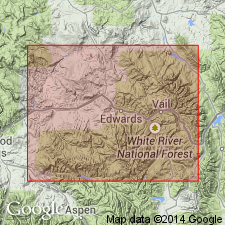
- Usage in publication:
-
- Parting quartzite member*
- Modifications:
-
- Areal extent
- AAPG geologic province:
-
- Eagle basin
Summary:
Pg. 152 (table 1), 170-174. Parting quartzite member of Chaffee formation. Described in Pando area, Eagle County, Colorado, where it is 45 to 57 feet thick, conformably underlies Dyer dolomite member, and unconformably overlies Harding quartzite. [Age is Late Devonian.]
Source: US geologic names lexicon (USGS Bull. 1200, p. 2933-2934).
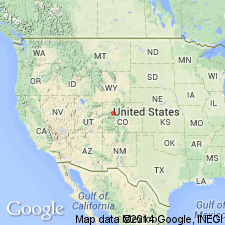
- Usage in publication:
-
- Parting member*
- Modifications:
-
- Contact revised
- AAPG geologic province:
-
- Piceance basin
Summary:
Lower contact revised in that Parting member of Chaffee formation overlies the newly named Tie Gulch member of Manitou formation in Glenwood Canyon, Garfield Co, CO in Piceance basin. Is of Late Devonian age.
Source: GNU records (USGS DDS-6; Denver GNULEX).
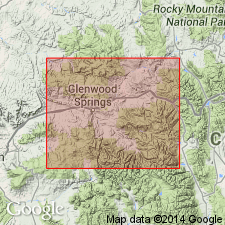
- Usage in publication:
-
- Parting Formation
- Modifications:
-
- Revised
- Overview
- AAPG geologic province:
-
- Piceance basin
- Green River basin
- Eagle basin
Summary:
Rank raised and assigned as lower of two formations of Chaffee Group (rank raised). Parting occurs in Rio Blanco and Garfield Cos, Piceance basin; Routt Co, Greater Green River basin; and Eagle and Pitkin Cos, Eagle basin. Informally divided into (ascending) units A, B, and C. Unit A consists of medium- to coarse-grained quartzose sandstone. Unit B consists of a basal gray shale; a thin, dense, dark-gray, irregularly bedded dolomite; an upper gray shale; and a thin sandy dolomite, dolomitic sandstone or interbedded dolomite and sandstone at top. Unit C ranges from shale to dolomite to quartzose sandstone. Units are readily recognizable in western part of study area, but are obscured in east and northeast because of facies changes. Isopach maps show unit A to range up to 50 ft thick; unit B ranges up to 40 ft thick; and unit C to range up to 100 ft thick. Conformably underlies Dyer Formation (rank raised) of Chaffee; unconformably overlies Harding Formation or older rocks. Measured section; fence diagram. Late Devonian age based on fossil fish; Baars and Campbell (1968, Mountain Geologist, v. 5, no. 1, p.31-40) assign it a Frasnian age.
Source: GNU records (USGS DDS-6; Denver GNULEX).
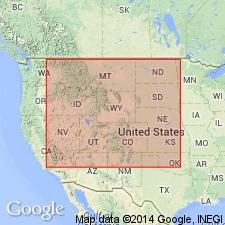
- Usage in publication:
-
- Parting Formation*
- Modifications:
-
- Biostratigraphic dating
- AAPG geologic province:
-
- Eagle basin
- Piceance basin
Summary:
Is 29 m thick; lies above Manitou Dolomite and beneath Coffee Pot Member of Dyer Dolomite of Chaffee Group in a measured section on the Eagle-Garfield Co line at east end of Glenwood Canyon, CO in the Eagle and Piceance basins. Upper part of formation is in the conodont zone, Upper POLYGNATHUS STYRIACUS zone. Considered to be of Famennian, Late Devonian age at this locality.
Source: GNU records (USGS DDS-6; Denver GNULEX).
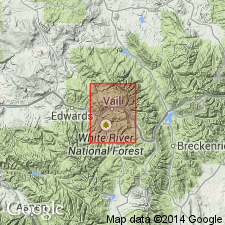
- Usage in publication:
-
- Parting Formation*
- Modifications:
-
- Overview
- Redescribed
- Dominant lithology:
-
- Quartzite
- Conglomerate
- Shale
- AAPG geologic province:
-
- Eagle basin
Summary:
Lowest of three formations of Chaffee Group (revised). Redescribed as "Formation" because of a mixed lithology consisting of quartzite, quartzite conglomerate, and, locally, shale. Study area is Minturn quad, Eagle and Summit Cos, CO, Eagle basin. Quartzite is typically light tan to white, poorly sorted, coarse grained, thick-bedded to massive, cross-bedded, vitreous, and is composed almost entirely of quartz. Quartzite conglomerate consists of well-rounded to angular white and pink quartz pebbles and generally occurs at base of quartzite and as scattered lenses throughout unit. Shale is turquoise-green, that in places is streaked and mottled maroon; occurs in local thin beds and in thick lenses that locally constitute up to half the thickness of formation; much of shale is sandy and some contains thin beds of vitreous white quartzite. In southwest part of quad, Parting is 40-65 ft thick; in fault blocks along Gore fault in Gore Range, Parting is 10-30 ft thick. Unit thins and youngs northeastward. Measured section; geologic map; stratigraphic chart. Unconformably overlies Harding Sandstone; conformably underlies Dyer Dolomite (redescribed, age modified) of Chaffee. Fossil fish, including BOTHRIOLEPIS, suggest early Late Devonian age; brachiopod PAURORHYNCA ENDLICHI and conodont ?CLYDGNATHUS ORMISTONI suggest late Late Devonian age, youngest age reported for Parting.
Source: GNU records (USGS DDS-6; Denver GNULEX).
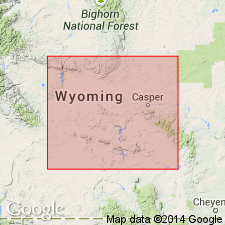
- Usage in publication:
-
- Parting Formation*
- Modifications:
-
- Overview
Summary:
Thought to be correlative with and be about the same age as the Fremont Canyon Sandstone, a new name in southeast WY (Wind River, Powder River, and Denver basins).
Source: GNU records (USGS DDS-6; Denver GNULEX).
For more information, please contact Nancy Stamm, Geologic Names Committee Secretary.
Asterisk (*) indicates published by U.S. Geological Survey authors.
"No current usage" (†) implies that a name has been abandoned or has fallen into disuse. Former usage and, if known, replacement name given in parentheses ( ).
Slash (/) indicates name conflicts with nomenclatural guidelines (CSN, 1933; ACSN, 1961, 1970; NACSN, 1983, 2005, 2021). May be explained within brackets ([ ]).

